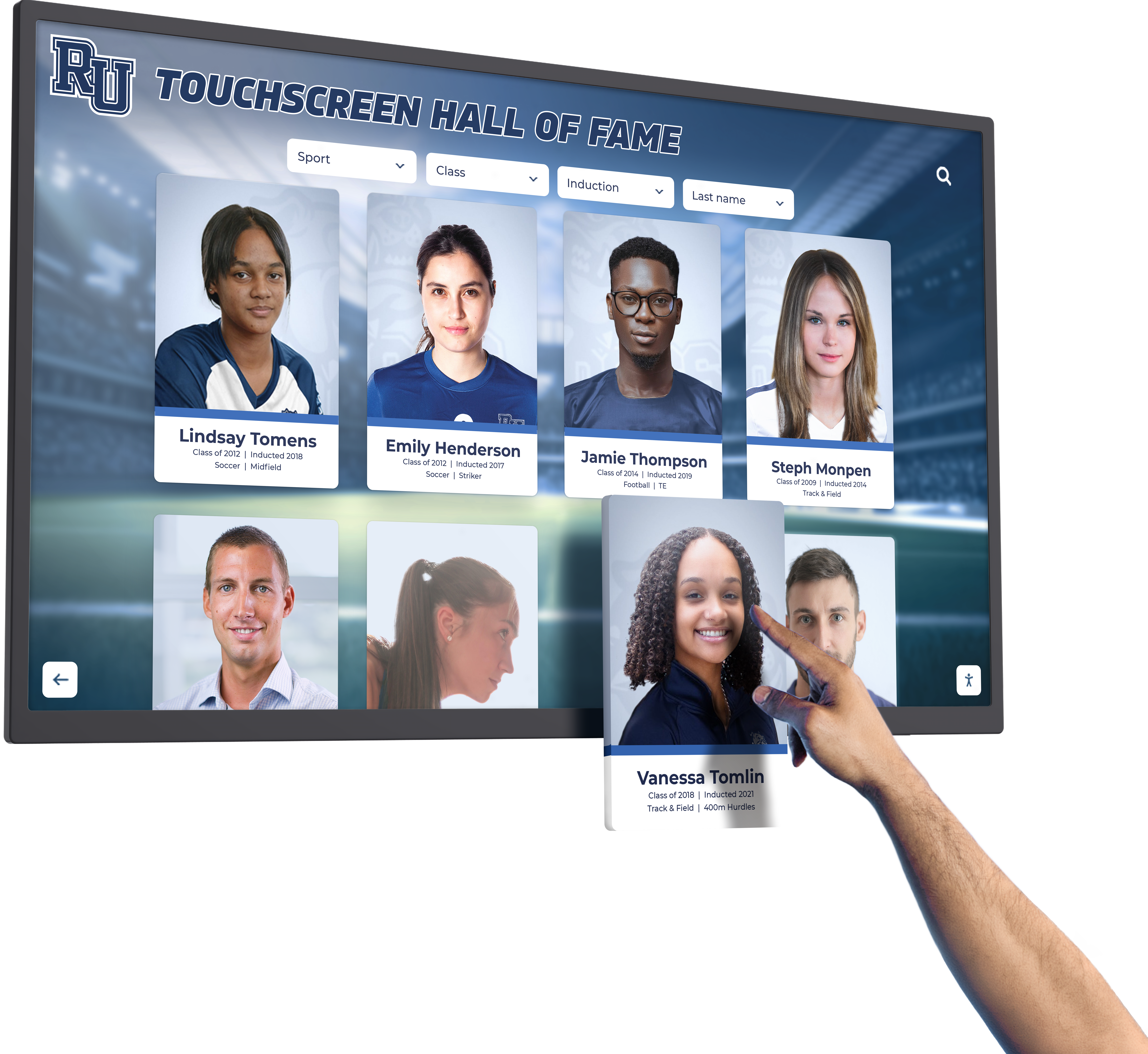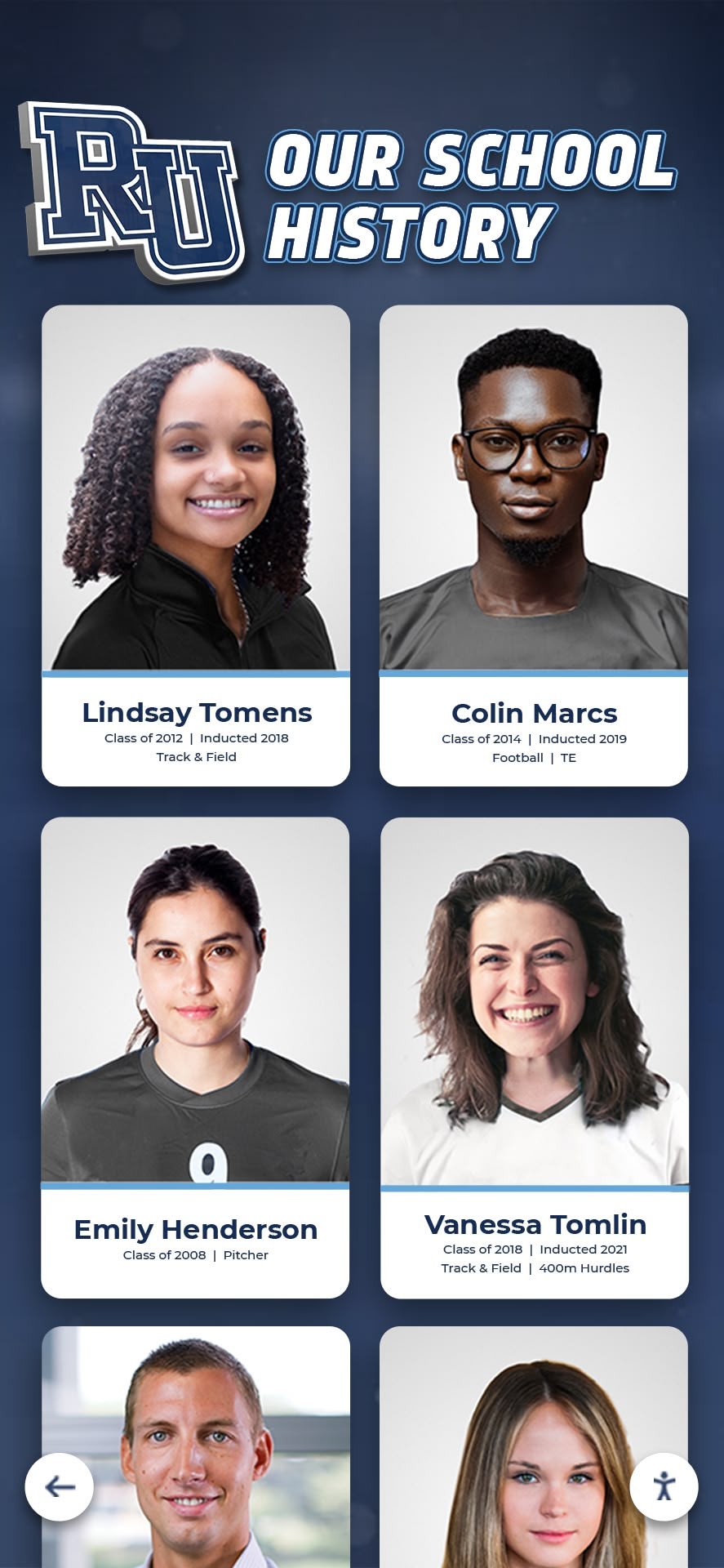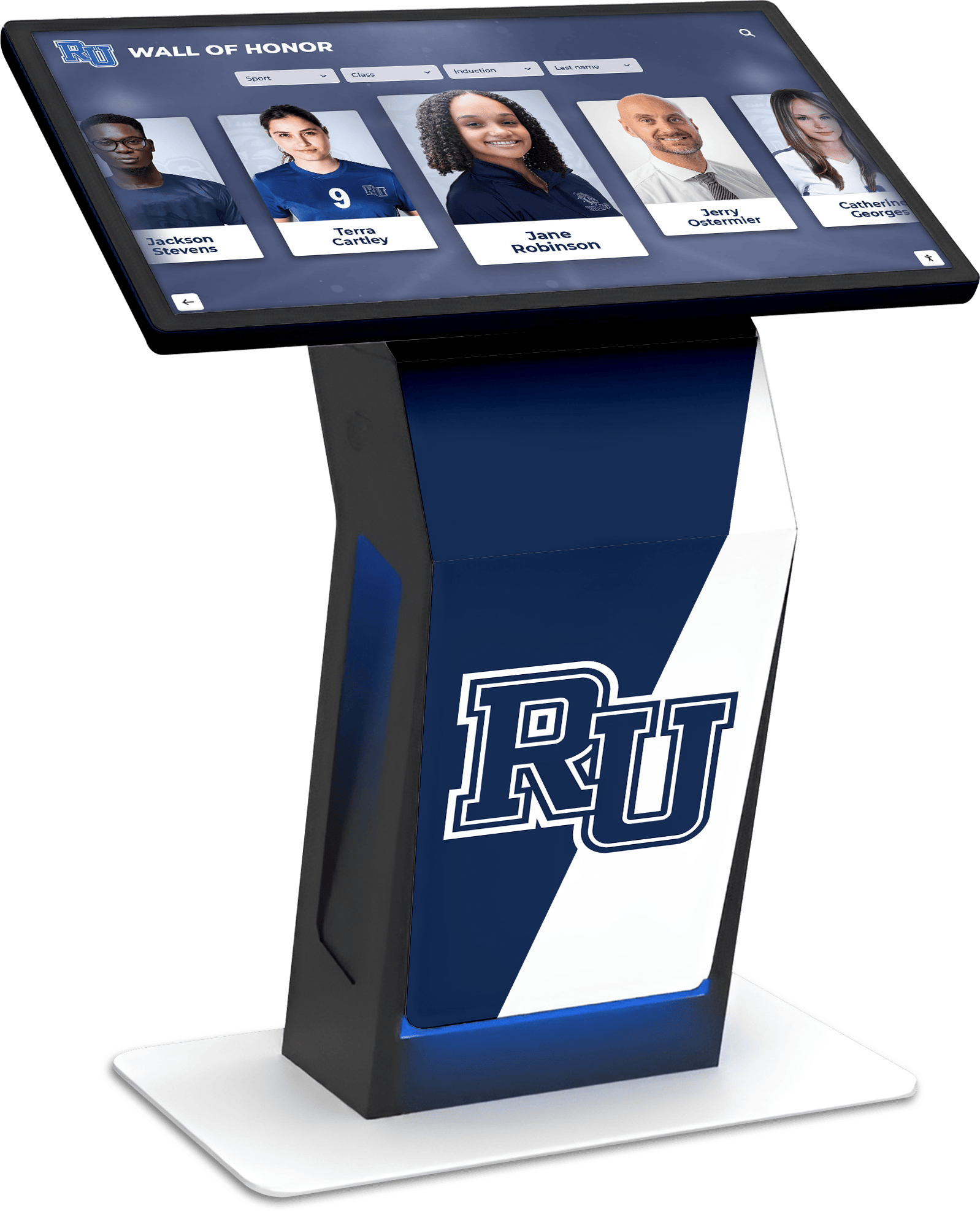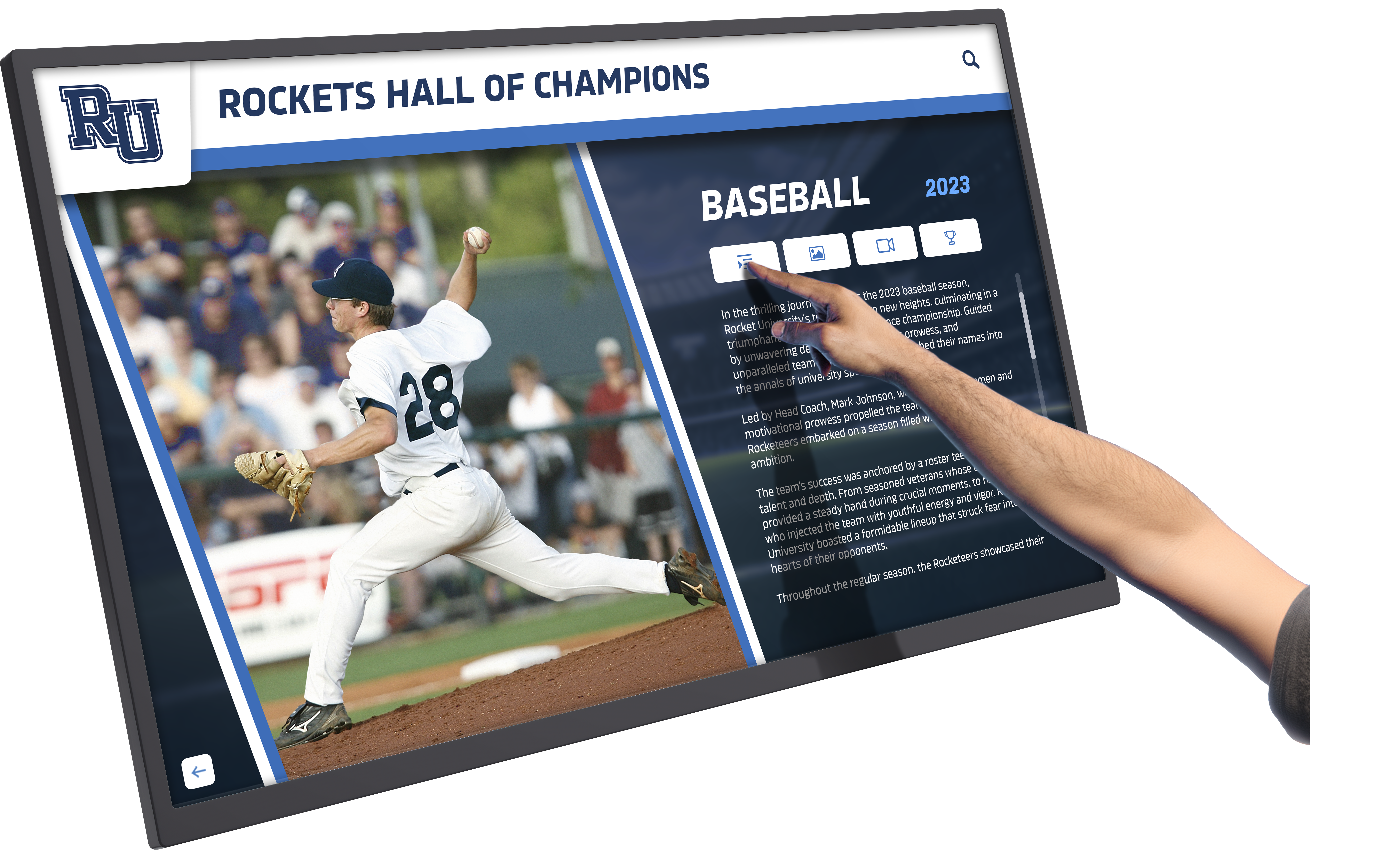Every school has them—championship trophies, individual awards, team plaques, and recognition pieces that no longer fit in the trophy case. These achievements, representing years of dedication, record-breaking performances, and unforgettable victories, sit in cardboard boxes in closets, gather dust in storage rooms, or line the shelves of athletic offices where few people ever see them.
The problem isn’t that schools don’t value these accomplishments. It’s that traditional trophy cases have finite space, and as programs grow and achievements multiply, administrators face impossible decisions about what to display and what to hide away. A typical glass-fronted trophy case might hold 20-40 trophies comfortably, but a successful athletic program can accumulate hundreds of awards over just a decade.
Digital trophy display technology is changing this equation entirely. Schools across the country are discovering that interactive touchscreen displays can showcase unlimited achievements with rich context, multimedia content, and engaging presentations that traditional trophy cases simply cannot match. More importantly, they’re finally bringing hidden trophies out of storage and giving every achievement the recognition it deserves.
This comprehensive guide explores how schools are using digital trophy displays to solve the hidden trophy problem, create engaging recognition experiences, and ensure every achievement receives the visibility it deserves.
Understanding the Trophy Case Space Crisis
The Mathematics of Limited Space
Traditional trophy cases face fundamental space limitations that worsen over time. Consider a typical scenario:
Standard Trophy Case Capacity:
- Average glass-fronted trophy case: 6 feet wide × 4 feet tall × 12 inches deep
- Realistic capacity: 25-35 trophies depending on size
- Multiple cases might increase capacity to 100-150 trophies total
Annual Achievement Accumulation:
- Athletic program with 15-20 sports
- Conference championships: 3-5 per year
- District/regional championships: 2-4 per year
- State championships: 1-2 per year
- Individual achievement awards: 10-20 per year
- Coach recognition: 2-5 per year
- Total new trophies annually: 18-36
The Growing Gap: After just 5 years, schools accumulate 90-180 new trophies. After 10 years, 180-360 trophies. After 20 years, 360-720 trophies. Yet trophy case capacity remains fixed at 100-150 items, creating an ever-widening gap between achievements earned and achievements displayed.

The Impossible Choices
When trophy cases fill completely, administrators face difficult decisions:
Option 1: Rotate Displays Periodically remove older trophies to make room for recent achievements. This approach ensures current accomplishments receive recognition but relegates historical achievements to storage, where they become increasingly forgotten.
Option 2: Display Only Top Achievements Show only the most prestigious awards—state championships, major conference titles, record-breaking performances. This maintains focus on elite accomplishments but fails to recognize the majority of team and individual successes.
Option 3: Create Crowded Displays Cram more trophies into existing cases than they’re designed to hold. This maximizes quantity but creates cluttered, visually unappealing displays where individual achievements become difficult to distinguish and appreciate.
Option 4: Accept Storage Reality Acknowledge that most trophies will live in storage, with only a curated selection on display. This pragmatic approach accepts limited space but means the majority of achievements remain hidden from view.
None of these options is satisfactory. Each approach fails to honor the full scope of achievement and hard work that trophies represent.
The Psychological Impact of Hidden Trophies
When trophies disappear into storage, the impact extends beyond physical visibility:
For Current Athletes: Walking past trophy cases displaying achievements creates aspirational motivation. When recent championships aren’t displayed due to space limitations, current athletes miss opportunities to see themselves represented in school history and feel the pride of public recognition.
For Alumni: Returning to campus and finding their championship trophy no longer displayed—replaced by more recent achievements—can feel like their accomplishments have been erased or devalued. The emotional connection to their school weakens when their contributions aren’t visibly honored.
For Prospective Students: Families touring schools evaluate athletic program strength partially through trophy displays. When space constraints prevent schools from showcasing their full history of achievement, programs may appear less successful than they actually are.
For Community Pride: Trophy cases serve as focal points for school pride and tradition. When they can’t accommodate all achievements, the full story of excellence and community success remains incomplete and underappreciated.
How Digital Trophy Displays Solve the Space Problem
Unlimited Capacity Through Digital Architecture
Digital trophy displays eliminate space constraints entirely through cloud-based content management systems that store unlimited achievements. A single touchscreen installation can showcase:
- Thousands of individual trophies with detailed photos
- Complete team rosters with individual athlete profiles
- Championship season highlights and statistics
- Historical achievement timelines spanning decades
- Coach profiles and career accomplishments
- Record progressions showing how achievements evolved
- Video footage of championship moments and celebrations
The physical display footprint remains constant—typically a single wall-mounted touchscreen—while the content capacity grows infinitely. Schools can add new achievements continuously without ever running out of space or removing existing content.

Making Hidden Trophies Accessible Again
Digital displays provide systematic approaches to bringing storage trophies back into visibility:
Complete Digitization Projects: Schools photograph every trophy in their collection—both displayed and stored—creating digital archives that preserve and showcase all achievements regardless of physical location. High-resolution images capture engraving details, trophy design, and historical significance that might be difficult to see even when trophies are physically displayed behind glass.
Contextual Enhancement: Digital profiles transform simple trophies into comprehensive stories. A state championship trophy photographed in storage becomes a rich digital presentation featuring the trophy image, team roster with photos, season record and statistics, game-by-game results, championship game highlights, coach quotes and reflections, newspaper clippings and media coverage, and current updates on team members’ lives.
Search and Discovery Features: Interactive search functionality helps visitors find specific achievements, athletes, or time periods instantly. Someone looking for 1995 basketball championships or searching for a specific athlete can locate relevant content immediately, rather than hoping that achievement happens to be among the limited items currently on physical display.
Organized Category Navigation: Digital systems organize achievements by sport, year, achievement type, individuals, and custom categories. This structure helps visitors explore content systematically and discover achievements they might not have known existed.
Real-World Implementation Example
Consider Lincoln High School’s transformation (representative example based on common implementation patterns):
Before Digital Display:
- 4 trophy cases with 120 displayed trophies
- 340 additional trophies in storage
- Athletic director spent 2-3 hours quarterly rotating displays
- Alumni frequently asked why specific trophies weren’t visible
- New trophies often stayed in offices for months awaiting case space
After Digital Display:
- 1 large touchscreen in main athletics hallway
- All 460 trophies photographed and digitally displayed
- Complete team rosters and athlete profiles for each championship
- Video highlights for recent championships
- Content updates happen in minutes via cloud platform
- Alumni engagement increased as they discovered their achievements now accessible
- Current athletes regularly interact with display, exploring team history
The transition from physical trophy cases to digital displays provided not just more capacity but fundamentally better recognition that honors every achievement while creating engaging experiences impossible with traditional cases.
Key Features of Effective Digital Trophy Displays
Comprehensive Trophy Documentation
Successful digital trophy displays go beyond simply photographing trophies:
Multi-Angle Trophy Photography: Professional images showing trophies from multiple perspectives, close-ups of engravings and details, scale references showing trophy size, and contextual photos showing trophies in original cases or presentations.
Detailed Achievement Information: Championship level and competition details, year and specific dates, team or individual recipients, coaches and support staff, season records and statistics, competition context and historical significance, and related achievements creating connected narratives.
Rich Media Integration: Championship game video highlights, team and individual photos, newspaper clippings and media coverage, ceremony footage and celebrations, and current updates on recipients’ lives and careers.

Intuitive Navigation and Search
Digital trophy displays must balance comprehensive content with accessible user experience:
Multiple Navigation Pathways: Browse by sport or activity, filter by year or era, search by athlete or coach name, view by achievement type (conference, district, state), and explore featured content and rotating highlights.
Powerful Search Functionality: Text search across all content fields, filters combining multiple criteria, related content suggestions, and popular content recommendations based on engagement.
Visual Design Excellence: Clear hierarchy emphasizing key information, consistent layouts across content types, high-contrast text for readability, engaging visual elements and multimedia, and responsive design adapting to screen size and orientation.
Mobile and Web Integration
The most effective digital trophy displays extend beyond single physical installations:
Web-Based Access: Online trophy cases accessible from any device, allowing alumni to explore achievements remotely, prospective families to research programs before visiting, and community members to celebrate achievements from anywhere.
QR Code Integration: Physical elements throughout campus featuring QR codes linking to digital content, maintaining small physical displays with extended digital information, and creating campus-wide recognition ecosystem connecting multiple locations.
Social Sharing Capabilities: Easy sharing of achievements on social media platforms, celebration announcements for new additions, alumni engagement through rediscovered achievements, and recruitment content showcasing program excellence.

Implementation Strategies for Schools
Phase 1: Assessment and Planning
Inventory Your Trophy Collection: Document all trophies currently displayed and stored, photograph each trophy with detailed views, record achievement information and context, assess trophy condition and historical significance, and identify which achievements have supporting materials (photos, videos, documents).
Define Your Objectives: Determine primary goals—comprehensive archive, enhanced engagement, space reclamation, alumni connection, or recruitment enhancement. Set priorities for which content to digitize first. Establish budget parameters and timeline expectations. Identify stakeholders to involve in planning.
Location Selection: Choose high-traffic areas maximizing visibility, ensure appropriate viewing distances and interaction space, verify network connectivity and power availability, consider security and environmental factors, and plan for potential expansion to additional locations.
Phase 2: Content Development
Professional Photography: High-resolution trophy images with consistent lighting and backgrounds, multiple angles showcasing details, close-ups ensuring engraving readability, and contextual shots showing scale and setting.
Data Collection and Research: Gather achievement details from records and archives, interview coaches and athletes about significant championships, collect team photos and action shots from competitions, locate newspaper clippings and media coverage, and document stories and anecdotes that provide context.
Digital Asset Organization: Implement systematic digital asset management with consistent naming conventions, logical folder structures, comprehensive metadata tagging, and quality control processes ensuring accuracy and completeness.
Phase 3: Platform Selection and Setup
Evaluate Digital Recognition Platforms: Solutions like Rocket Alumni Solutions specialize in school recognition needs, offering intuitive content management systems designed for non-technical users, cloud-based architecture enabling access from anywhere, purpose-built templates for trophies and achievements, robust search and navigation capabilities, and comprehensive support for implementation and ongoing management.
Hardware Selection: Choose appropriate touchscreen displays based on location, viewing distance, and budget. Consider commercial-grade equipment designed for continuous public use, sufficient screen size for comfortable interaction (typically 43"-75"), and mounting options (wall-mounted, freestanding kiosk, or custom enclosure).
Installation and Configuration: Professional installation ensuring proper mounting and security, network configuration for reliable connectivity, system testing and quality assurance, and staff training on content management and basic troubleshooting.

Phase 4: Content Migration and Launch
Phased Content Deployment: Launch with high-priority content (recent championships, major achievements), regularly add additional historical content on schedule, maintain momentum with consistent updates and new features, and celebrate milestones as complete sports or eras are added.
Launch Event and Promotion: Host unveiling ceremony during homecoming or major school event, demonstrate features and navigation to stakeholders, recognize staff and volunteers who contributed to implementation, promote through school communications, social media, and local media, and create excitement around newly accessible achievements.
Ongoing Content Management: Establish processes for adding new achievements promptly, schedule regular content reviews and updates, maintain quality standards for photos and information, engage alumni in contributing memories and updates, and track engagement metrics to identify popular content and improvement opportunities.
Addressing Common Questions and Concerns
“What happens to our physical trophies?”
Digital displays don’t require eliminating physical trophies. Many schools implement hybrid approaches:
Maintain Select Physical Displays: Keep one or two trophy cases for the most historically significant championships, create rotating physical displays that change seasonally or annually, feature physical trophies for current year championships before transitioning to digital, and maintain museum-quality displays for rare or valuable awards.
Return Trophies to Recipients: Offer to return individual and team trophies to athletes and coaches who earned them, host trophy pickup events during reunions or homecoming, and create positive alumni engagement opportunities while reducing storage needs.
Responsible Repurposing: Donate trophies to recycling programs that repurpose materials, offer trophies to youth programs for participation awards, or create art installations featuring trophy elements.
Archive Significant Items: Maintain climate-controlled storage for historically significant trophies, implement proper archival techniques preventing deterioration, and ensure items remain accessible for special exhibitions or occasions.
“How much does a digital trophy display cost?”
Investment varies based on scope and features:
Hardware Costs: Commercial touchscreen display: $2,000-$8,000 depending on size, mounting solutions (wall mount, kiosk, custom enclosure): $500-$3,000, and media player or computer: $500-$1,500.
Software and Platform: Annual licensing for professional digital recognition software: $1,200-$6,000, cloud hosting and content delivery, ongoing updates and feature improvements, and technical support and training.
Implementation Services: Professional photography of trophy collection, content development and data entry, installation and configuration, and staff training.
Total Investment Range: Basic single-display implementation: $8,000-$15,000 first year, comprehensive multi-display system: $20,000-$40,000 first year, and ongoing annual costs: $1,500-$8,000 for software, updates, and content management.
Return on Investment: Eliminated costs for new trophy purchases and engraving (typically $2,000-$5,000 annually), reduced staff time managing physical displays, space reclaimed from trophy cases for other uses, enhanced alumni engagement and fundraising potential, and improved recruitment appeal for prospective students.

“What about technology failures or obsolescence?”
Modern digital displays offer excellent reliability:
Hardware Reliability: Commercial-grade displays designed for continuous operation, typical lifespan of 5-7 years with proper maintenance, extended warranty options available, and higher uptime rates than concerns suggest (often 98%+ when properly implemented).
Software Longevity: Cloud-based platforms update automatically without hardware changes, content remains accessible and transferable across system upgrades, responsive design adapts to evolving display technologies, and vendor support ensures ongoing compatibility and improvements.
Backup and Redundancy: Content stored in cloud with automatic backups, easy restoration if hardware requires replacement, offline content options for network interruptions, and clear support channels for technical issues.
“Can we still add new achievements easily?”
Digital platforms dramatically simplify content updates:
Quick Addition Process: Photograph new trophy or achievement, log into cloud-based content management system, create new entry using pre-built template, upload photos and enter details, and publish immediately or schedule for specific date.
Time Requirements: Adding new trophy entry: 10-15 minutes, updating existing content: 5-10 minutes, and significantly faster than physical trophy case updates requiring unlocking cases, rearranging existing trophies, physical installation, and relocking.
Flexibility: Add content from any location with internet access, schedule automated publication dates, make corrections or updates anytime, and no space constraints limiting what can be added.
Enhancing Recognition Beyond Physical Trophies
From Trophy to Story
Digital displays transform trophies from physical objects into comprehensive narratives:
Championship Context: Season journey leading to championship, key games and turning points, statistics and records set, challenges overcome along the way, and significance within program history.
Individual Spotlights: Athlete biographies and backgrounds, career highlights and achievements, memorable moments and performances, post-graduation updates and accomplishments, and connections to current programs and mentoring.
Coach Legacies: Coaching philosophy and approach, program development and evolution, athletes developed and championships won, impact on school culture and community, and recognition and honors received.
Program Evolution: Historical trends and patterns, record progressions over time, era-defining teams and athletes, facility and resource development, and traditions established and maintained.
Interactive Engagement Features
Modern interactive displays create engaging experiences:
Timeline Visualizations: Chronological views showing achievement progression, era filtering to explore specific time periods, milestone markers for significant achievements, and animated transitions revealing historical development.
Statistical Comparisons: All-time record boards across sports, decade-by-decade performance comparisons, conference and state success rates, and individual versus team achievement balances.
Connection Networks: Related achievements and athletes, coaching trees and mentor relationships, family legacies across generations, and teammate and competitor connections.
Multimedia Experiences: Video highlights of championship moments, photo galleries with historical images, audio recordings of interviews or commentary, and interactive statistics and record visualizations.
Future Trends in Digital Trophy Recognition
Artificial Intelligence Integration
Emerging AI capabilities enhance digital trophy displays:
Automated Content Generation: AI-assisted caption writing from images, automated fact-checking against historical records, intelligent tagging and categorization, and suggested connections between related content.
Personalized Experiences: Recognition of returning visitors showing relevant content, adaptive navigation based on interaction patterns, personalized achievement highlights for alumni, and intelligent recommendations for related content.
Voice Interaction: Hands-free navigation through voice commands, verbal searches for specific achievements or athletes, audio descriptions for accessibility, and conversational interfaces for natural interaction.
Augmented Reality Enhancements
AR technology adds new dimensions to digital trophy recognition:
Virtual Trophy Viewing: 3D models of trophies viewable from all angles, AR overlays on mobile devices showing trophy details, virtual trophy rooms accessible from anywhere, and scale visualizations showing actual trophy sizes.
Historical Scene Recreation: AR overlays showing championship moments in specific locations, visualization of historical events in current campus spaces, interactive timelines overlaid on physical environments, and immersive storytelling through layered content.
Social Integration Evolution
Enhanced social connectivity amplifies recognition:
Community Contribution: Alumni submissions of photos and stories, crowd-sourced historical information, collaborative memory building, and verified community knowledge integration.
Live Achievement Feeds: Real-time updates during competitions, instant recognition publication for new achievements, social media integration for immediate sharing, and notification systems for interested community members.
Conclusion: Giving Every Trophy the Recognition It Deserves
The hidden trophy problem facing schools isn’t about a lack of achievement or pride—it’s about the inherent limitations of physical display space and the growing gap between accomplishments earned and accomplishments visible. Digital trophy displays solve this fundamental space constraint while simultaneously enhancing recognition through rich multimedia content, interactive engagement, and unlimited capacity.
Schools implementing digital trophy displays consistently report similar outcomes: hidden trophies photographed and made accessible, alumni reconnecting with their achievements and school communities, current athletes exploring program history and gaining motivation, enhanced campus tours showcasing full achievement scope, reduced administrative burden for managing physical displays, and space reclaimed from trophy cases for other valuable uses.
Most importantly, every achievement finally receives the recognition it deserves. No more impossible choices about which trophies to display and which to hide. No more champions whose awards sit unseen in storage. No more incomplete stories of excellence due to space limitations.
Digital trophy displays honor every victory, every championship, every record-breaking performance, and every moment of excellence that defines your school’s history. They transform trophy recognition from static physical objects behind glass into dynamic, engaging stories that inspire current students, reconnect alumni, and celebrate the full scope of achievement your community has earned.
Ready to bring your hidden trophies out of storage and create comprehensive digital recognition showcasing every achievement? Rocket Alumni Solutions specializes in helping schools implement digital trophy displays and interactive recognition systems that preserve history, engage communities, and ensure no achievement remains hidden.
Your trophies represent dedication, hard work, and moments of triumph. They all deserve to be seen, celebrated, and remembered. Digital trophy displays make that possible.




































